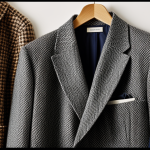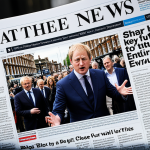Historical Evolution of Vintage Fashion in the UK
Vintage fashion history UK spans distinct fashion eras, each marked by unique style shifts that reflect broader societal changes. Starting with the 1920s, the flapper dresses symbolized women’s newfound freedom—dropping waistlines and beaded embellishments capturing the Jazz Age spirit. The 1940s wartime era brought a practical yet resilient silhouette, with utility fabrics and tailored suits reflecting austerity and strength.
The 1960s mod era introduced youthful energy through bold geometric patterns and mini skirts, a radical shift in the women’s style timeline. By the 1970s, bohemian elements—flowing fabrics, ethnic prints—expressed counterculture values, while the 1980s ushered in power dressing with sharp shoulders and commanding tailoring, mirroring women’s growing presence in the workplace.
Also to read : How Can You Transform Classic British Fashion Staples into Modern Wardrobe Essentials?
Finally, 1990s minimalism simplified the silhouette to clean lines and muted palettes, emphasizing understated elegance. Throughout these fashion eras, enduring UK fashion icons like Mary Quant and Vivienne Westwood did not just influence style but reshaped cultural attitudes. Their innovative approaches fostered an ongoing dialogue between past and present, anchoring the vintage fashion history UK firmly within both the historical and contemporary style landscape.
Historical Evolution of Vintage Fashion in the UK
Exploring vintage fashion history UK reveals a dynamic journey through distinct fashion eras reflecting social change and cultural identity. The 1920s flapper era introduced bold liberation with dropped waists and fringe, challenging traditional women’s garments. Moving into the 1940s wartime period, practicality dominated: utility clothing featured tailored suits and muted tones, reflecting scarcity and resilience.
Also to see : How Can You Personalize Your Wardrobe with UK Women’s Fashion Trends?
The 1960s mod movement epitomised youthful rebellion, marked by geometric patterns, mini skirts, and vibrant colours. The 1970s embraced bohemian freedom with flowing fabrics and ethnic prints, signalling a shift toward individuality in women’s style timeline. The 1980s highlighted power dressing—structured shoulders and sharp tailoring conveyed confidence and career ambition. In contrast, the 1990s minimalism favoured simplicity, clean lines, and muted palettes, influencing future decades.
Throughout these eras, British icons such as Twiggy and Vivienne Westwood left indelible marks, their styles becoming touchstones for vintage fashion history UK. Understanding these phases helps decode the ongoing revival of vintage elements in today’s fashion, tracing a continuum that blends nostalgia with innovation. This historical context enriches appreciation of how past aesthetics permeate contemporary UK wardrobes.
Vintage Trends Resurfacing in Modern UK Women’s Fashion
Vintage clothing influence is unmistakable in today’s modern UK women’s trends. Styles from various fashion eras, once considered nostalgic, now find fresh life on high streets and in designer collections. For example, the puff sleeves and midi skirts popularized in the 1940s and 1970s have reappeared, blending classic charm with contemporary flair.
Bold prints, emblematic of the 1960s mod era, are frequently featured in current collections. Tailoring reminiscent of 1980s power dressing—sharp lines and defined shoulders—returns as a statement of confidence in women’s wardrobes. Statement accessories such as oversized hats and vintage-inspired bags complete these revitalized looks.
High-profile UK celebrities and designers actively champion this style revival, encouraging wider acceptance of vintage during everyday dressing. By embracing vintage clothing influence, modern UK women connect the past’s elegance with today’s fashion versatility, creating a rich dialogue between eras. This resurgence reflects not just cyclical trends but a deeper appreciation for sustainable, meaningful clothing choices that honor the women’s style timeline rich in cultural significance.
Vintage Trends Resurfacing in Modern UK Women’s Fashion
Vintage clothing influence thrives in today’s UK women’s trends, showcasing a vibrant style revival rooted in past fashion eras. Key pieces from the vintage fashion history UK like midi skirts and puff sleeves have made a triumphant return on the high street and in designer collections. The flared midi skirts evoke 1970s bohemian softness, while puff sleeves channel the dramatic silhouettes popular in the 1980s power dressing era. Bold prints, often geometric or floral, also reflect the 1960s mod and 1970s aesthetics, bringing fresh life to modern wardrobes.
Tailoring, a legacy of 1940s wartime practicality and 1980s sharp cuts, reappears in structured blazers and trousers, blending vintage charm with contemporary polish. Statement accessories such as oversized hats and vintage-style handbags complete these looks, anchoring the women’s style timeline firmly in a celebratory resurgence of classic elements.
High-profile UK celebrities and designers actively revive vintage aesthetics, influencing everyday fashion enthusiasts and driving demand for these nostalgic yet modern pieces. This ongoing trend signifies not just a fleeting moment but a meaningful dialogue between past and present styles within UK fashion’s evolving narrative.
Historical Evolution of Vintage Fashion in the UK
Tracing vintage fashion history UK reveals a rich tapestry shaped by six defining fashion eras. The 1920s flapper era broke conventions with dropped waists and fringe, spotlighting newfound women’s freedom. Wartime in the 1940s shifted focus to practicality through utility fabrics and tailored silhouettes, mirroring resilience amidst scarcity.
The 1960s mod period injected boldness with geometric prints and mini skirts, capturing youthful rebellion on the women’s style timeline. Bohemian vibes took hold in the 1970s, characterized by flowing fabrics and ethnic motifs, emphasizing individualism. The 1980s power dressing era featured sharp shoulders and structured tailoring, reflecting women’s expanding workplace roles and confidence.
Minimalism defined the 1990s, favoring clean lines and muted palettes that streamlined women’s fashion while influencing future trends. Icons like Vivienne Westwood and Mary Quant profoundly shaped these eras, their designs transcending style to challenge cultural norms and inspire ongoing reinterpretations.
Understanding these distinct fashion eras clarifies the enduring vitality of vintage within UK wardrobes, showcasing how each chapter in the women’s style timeline contributes unique expressions to contemporary fashion’s vocabulary.
Historical Evolution of Vintage Fashion in the UK
Tracing vintage fashion history UK reveals a rich tapestry woven through distinct fashion eras, each embodying prevailing cultural moods and shifting societal roles, especially within the women’s style timeline. The 1920s flapper era broke conventions with its dropped waists and shimmering embellishments, mirroring women’s increasing social freedoms. Moving into the 1940s wartime period, fashion embraced utility and austerity—tailored suits and pragmatic fabrics reflected resilience and resourcefulness amid scarcity.
The 1960s mod era injected vibrant energy and youth rebellion through mini skirts, bold geometric prints, and vivid colors. In the 1970s, bohemian style awakened individual expression with flowing silhouettes and ethnic patterns, deviating from earlier conformity. The 1980s marked a shift to power dressing, with sharp-shouldered tailoring symbolizing women’s growing workplace stature and confidence. Finally, the 1990s minimalism distilled style to clean lines and muted tones, emphasizing simplicity and refined elegance.
Throughout these eras, influential UK icons like Mary Quant and Vivienne Westwood revolutionized design, embedding cultural narratives into fashion. Their legacy underpins the ongoing resonance of vintage elements, demonstrating that each fashion era contributes uniquely to the evolving women’s style timeline in Britain.
Historical Evolution of Vintage Fashion in the UK
The vintage fashion history UK spans six pivotal fashion eras, each reflecting major societal shifts alongside style evolution. The 1920s flapper era marked a departure from restrictive garments, introducing dropped waists and fringe that symbolised women’s newfound independence. During the 1940s wartime, fashion became utilitarian: practicality dominated with tailored suits and durable fabrics, mirroring a resilient spirit amid rationing.
The 1960s mod era injected vivid energy into the women’s style timeline through bold geometric prints and mini skirts—an emblem of youth rebellion and optimism. By the 1970s, the style shifted to bohemian freedom, characterised by flowing fabrics and ethnic prints representing individuality and cultural exploration.
In the 1980s, power dressing emerged, expressing women’s growing workplace influence with sharp shoulders and structured tailoring. This era’s designs communicated ambition and authority. The 1990s embraced minimalism, favouring clean lines and muted tones that simplified fashion while setting the stage for future reinterpretations.
Influential UK icons like Mary Quant and Vivienne Westwood not only shaped these eras but also propelled vintage’s ongoing relevance. Their revolutionary designs bridged past and present, embedding cultural commentary within the vintage fashion history UK narrative.
Historical Evolution of Vintage Fashion in the UK
The vintage fashion history UK unfolds across six pivotal fashion eras, each defining shifts in the women’s style timeline. The 1920s introduced the flapper look, with dropped waists and lavish embellishments embodying post-war liberation. In contrast, the 1940s wartime era emphasized practicality, utilising tailored suits and utility fabrics to reflect societal austerity and resilience.
The 1960s mod movement brought vibrant geometric prints and daring mini skirts, capturing youthful rebellion and energy. The 1970s embraced bohemian freedom with flowing fabrics and ethnic motifs, symbolizing individualism against prior conformity. Moving into the 1980s, power dressing took centre stage—structured shoulders and sharp tailoring communicated growing female confidence in professional spaces.
Finally, the 1990s introduced minimalism, favouring clean lines and understated palettes that streamlined the silhouette. Throughout these eras, British icons like Vivienne Westwood and Mary Quant didn’t merely influence trends but also redefined cultural attitudes toward women’s fashion. Their legacy ensures that each fashion era contributes distinctively to the evolving women’s style timeline, embedding historical and cultural significance into today’s vintage revival in the UK.
Historical Evolution of Vintage Fashion in the UK
The vintage fashion history UK is distinguished by six defining fashion eras, each contributing uniquely to the broader women’s style timeline. The 1920s flapper era introduced bold silhouettes with dropped waists and beading, symbolizing women’s newfound independence post-World War I. This liberation contrasted with the 1940s wartime era, which emphasized utility and resilience; fashion favored tailored suits, practical fabrics, and muted tones reflecting rationing and austerity.
The 1960s mod movement invigorated British style with bold geometric prints and mini skirts, capturing youthful rebellion and optimism. By the 1970s, the women’s style timeline embraced bohemian influences—flowing fabrics and ethnic patterns that expressed individuality and cultural curiosity. The 1980s power dressing era brought sharply structured shoulders and confident tailoring to forefront women’s growing workplace presence.
Finally, the 1990s minimalism distilled fashion to clean lines and muted palettes, prefacing subsequent reinterpretations of simplicity. Throughout these eras, UK pioneers such as Mary Quant and Vivienne Westwood reshaped cultural attitudes while anchoring each period in creative innovation. Their influence cements each fashion era as a vital chapter within Britain’s lasting vintage heritage.




